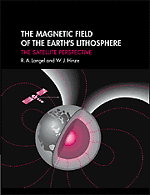Book contents
- Frontmatter
- Contents
- Preface
- 1 LITHOSPHERIC MAGNETIC FIELDS AT SATELLITE ALTITUDE
- 2 EARTH'S MAGNETIC FIELD
- 3 MEASUREMENT OF THE NEAR-EARTH MAGNETIC FIELD FROM SPACE
- 4 ISOLATION OF ANOMALY FIELDS
- 5 REDUCTION AND INVERSION
- 6 ANOMALY MAPS
- 7 MAGNETIC ANOMALIES AND THEIR SOURCES
- 8 METHODS IN INTERPRETATION
- 9 GLOBAL SATELLITE MAGNETIC ANOMALY INTERPRETATION
- Glossary of Symbols
- Common Abbreviations
- References
- Index
- Plate section
2 - EARTH'S MAGNETIC FIELD
Published online by Cambridge University Press: 06 December 2010
- Frontmatter
- Contents
- Preface
- 1 LITHOSPHERIC MAGNETIC FIELDS AT SATELLITE ALTITUDE
- 2 EARTH'S MAGNETIC FIELD
- 3 MEASUREMENT OF THE NEAR-EARTH MAGNETIC FIELD FROM SPACE
- 4 ISOLATION OF ANOMALY FIELDS
- 5 REDUCTION AND INVERSION
- 6 ANOMALY MAPS
- 7 MAGNETIC ANOMALIES AND THEIR SOURCES
- 8 METHODS IN INTERPRETATION
- 9 GLOBAL SATELLITE MAGNETIC ANOMALY INTERPRETATION
- Glossary of Symbols
- Common Abbreviations
- References
- Index
- Plate section
Summary
INTRODUCTION
To study the lithospheric component of the earth's magnetic field A(r), this anomaly field must be identified and isolated from the fields due to other sources. This chapter gives an overview of those other fields and of how they compare with A(r). Figure 2.1 schematically pictures the various source regions for the geomagnetic field. In the absence of outside currents and fields, the magnetic field of the earth would extend indefinitely into space. However, a plasma (ionized gas), called the solar wind, streams from the sun, enclosing the earth's magnetic field and confining it to a cavity called the magnetosphere. The outer boundary of the magnetosphere is called the magnetopause, and its inner boundary is the ionosphere. Except during magnetic storms, some 97–99% of the magnetic field at the earth's surface is produced by electric currents driven by a self-sustaining dynamo process in the earth's conducting liquid outer core. The resulting field is the main field, Bm in equation (1.5). The remainder of B is produced by electric currents induced in the earth by time variations in B (negligible in the present context), by remanent (permanent) and induced magnetization in the lithosphere [the A in equation (1.5)], by tidal currents excited by the ionospheric dynamo (driven mostly by the thermal solar tide), which are designated by S, and by the effects of the solar-wind plasma in distorting the magnetopause (the boundary of the magnetosphere) and in producing the currents in the magnetosphere and ionosphere that generate magnetic storms and substorms.
- Type
- Chapter
- Information
- The Magnetic Field of the Earth's LithosphereThe Satellite Perspective, pp. 18 - 39Publisher: Cambridge University PressPrint publication year: 1998



